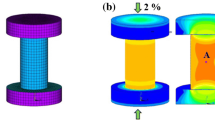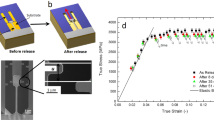Abstract
The film–substrate architectures are a promising design for improving tensile ductility of metallic glasses. Recent experiments have shown that cracking of amorphous metallic glass films is the major fracture mode of the film–substrate systems subjected to tensile loading. In this study, calculations are carried out for multiple cracking of an amorphous metallic glass film bonded to a ductile substrate. The pressure sensitive yielding, plastic dilatancy and post-yield strain softening caused by evolution of free-volume of the amorphous film are accounted for; furthermore, the competition between brittle cleavage and shear band induced cracking in the amorphous film is considered in the numerical analyses. It is found that for thin films, the multiple cracking behavior is associated with development of shear bands, and small crack spacing involves interaction of multiple shear bands, which can further activate the mechanism of substrate confinement and leads to large critical strain for film cracking. The multiple cracking in thick amorphous films is governed by brittle cleavage mechanism, which suppresses plastic deformation in the film and gives rise to small critical strain for film cracking. For the amorphous film with intermediate thickness, the shear band induced cracking dominates in the case of small crack spacing, while brittle cleavage mechanism is responsible for the multiple cracking of amorphous films with large crack spacing. The findings of this study shed new lights on the design of reliable film–substrate systems.














Similar content being viewed by others
References
An B (2019) Notch tip fields in amorphous films resting on ductile substrates. Eur J Mech A 75:1–9
An B, Sun W (2019) A theory of biological composites undergoing plastic deformations. J Mech Behav Biomed Mater 93:204–212
An B, Xu M (2019) Localized plastic deformation in amorphous films on a ductile substrate. Mech Mater 136:103084
Anand L, Su C (2005) A theory for amorphous viscoplastic materials undergoing finite deformations, with application to metallic glasses. J Mech Phys Solids 53:1362–1396
Bae JY, Gwak EJ, Hwang GS, Hwang HW, Lee DJ, Lee JS, Joo YC, Sun JY, Jun SH, Ok MR, Kim JY, Kang SK (2021) Biodegradable metallic glass for stretchable transient electronics. Adv Sci 8:2004029
Belytschko T, Chiapetta RL, Bartel HD (1976) Efficient large scale non-linear transient analysis by finite elements. Int J Numer Methods Eng 10:579–596
Cao QP, Ma Y, Wang C, Wang XD, Jiang JZ (2014) Effect of temperature and strain rate on deformation behavior in metallic glassy films. Thin Solid Films 561:60–69
Cao RQ, Pan J, Lin Y, Li Y (2019) Mechanical properties and optimum layer thickness in an amorphous Ni–P/coarse-grained Ni bi-layered structure. Mater Sci Eng A 760:458–468
Chen M (2008) Mechanical behavior of metallic glasses: microscopic understanding of strength and ductility. Annu Rev Mater Res 38:445–469
Chen Y, Dai LH (2016) Nature of crack-tip plastic zone in metallic glasses. Int J Plast 77:54–74
Chen T, Li J, Chen S, Li C (2020) Shear band multiplication induced strong strain delocalization and high tensile ductility in amorphous thin films by metallic substrates. Int J Solids Struct 195:1–12
Chu JP, Lee CM, Huang RT, Liaw PK (2011) Zr-based glass-forming film for fatigue-property improvements of 316L stainless steel: annealing effects. Surf Coat Technol 205:4030–4034
Demetriou MD, Launey ME, Garrett G, Schramm JP, Hofmann DC, Johnson WL, Ritchie RO (2011) A damage-tolerant glass. Nat Mater 10:123–128
Flores KM, Dauskardt RH (1999) Enhanced toughness due to stable crack tip damage zones in bulk metallic glass. Scr Mater 41:937
Gearing BP, Anand L (2004) Notch-sensitive fracture of polycarbonate. Int J Solids Struct 41:827–845
Greer AL (2009) Metallic glasses … on the threshold. Mater Today 12:14–22
Guo H, Yan PF, Wang YB, Tan J, Zhang ZF, Sui ML, Ma E (2007) Tensile ductility and necking of metallic glass. Nat Mater 6:735–739
Henann DL, Anand L (2009) Fracture of metallic glasses at notches: effects of notch-root radius and the ratio of the elastic shear modulus to the bulk modulus on toughness. Acta Mater 57:6057–6074
Hirmukhe SS, Prasad KE, Singh I (2021) Finite element analysis of deformation and failure mechanisms in nanoscale hexagonal cellular structures of metallic glasses. Mech Mater 160:103946
Hofmann DC, Suh JY, Wiest A, Duan G, Lind ML, Demetriou MD, Johnson WL (2008) Designing metallic glass matrix composites with high toughness and tensile ductility. Nature 451:1085–1090
Jeon C, Kim CP, Joo SH, Kim HS, Lee S (2013) High tensile ductility of Ti-based amorphous matrix composites modified from conventional Ti–6Al–4V titanium alloy. Acta Mater 61:3012–3026
Jia H, Liu F, An Z, Li W, Wang G, Chu J, Jang JSC, Gao Y, Liaw PK (2014) Thin-film metallic glasses for substrate fatigue-property improvements. Thin Solid Films 561:2–27
Jiang Y, Qiu K (2015) Computational micromechanics analysis of toughening mechanisms of particle-reinforced bulk metallic glass composites. J Mater Des 65:410–416
Lai J, Van der Giessen E (1997) A numerical study of crack-tip plasticity in glassy polymers. Mech Mater 25:183–197
Li T, Huang Z, Suo Z (2004) Stretchability of thin metal films on elastomer substrates. Appl Phys Lett 85:3435–3437
Li W, Bei H, Gao Y (2016) Effects of geometric factors and shear band patterns on notch sensitivity in bulk metallic glasses. Intermetallics 79:12–19
Liu Z, Li R, Liu G, Su W, Wang H, Li Y, Shi M, Luo X, Wu G, Zhang T (2012) Microstructural tailoring and improvement of mechanical properties in CuZr-based bulk metallic glass composites. Acta Mater 60:3128–3139
Liu Z, Chen W, Carstensen J, Ketkaew J, Mota RMO, Guest JK, Schroers J (2016) 3D metallic glass cellular structures. Acta Mater 105:35–43
Lu XL, Lu QH, Li Y, Lu L (2013) Gradient confinement induced uniform tensile ductility in metallic glass. Sci Rep 3:3319
Lu XL, Li Y, Lu L (2016) Co-existence of homogeneous flow and localized plastic deformation in tension of amorphous Ni–P films on ductile substrate. Acta Mater 106:182–192
Ma Y, Cao QP, Qu SX, Wang XD, Jiang JZ (2012) Effect of structural relaxation on plastic flow in a Ni–Nb metallic glassy film. Acta Mater 60:3667–3676
Nahta R, Moran B (1995) Crack spacing in brittle films on dissimilar planar and axisymmetric elastic substrates. Eng Fract Mech 52:513–524
Patnaik MNM, Narasimhan R, Ramamurty U (2004) Spherical indentation response of metallic glasses. Acta Mater 52:3335–3345
Qu RT, Wu SJ, Wang SG, Wang XD, Zhang ZF (2020) Shear banding stability and fracture of metallic glass: Effect of external confinement. J Mech Phys Solids 138:103922
Sarac B, Schroers J (2013) Designing tensile ductility in metallic glasses. Nat Commun 4:2158
Sarac B, Klusemann B, Xiao T, Bargmann S (2014) Materials by design: an experimental and computational investigation on the microanatomy arrangement of porous metallic glasses. Acta Mater 77:411–422
Schroers J, Johnson WL (2004) Ductile bulk metallic glass. Phys Rev Lett 93:255506
Schuh CA, Hufnagel TC, Ramamurty U (2007) Mechanical behavior of amorphous alloys. Acta Mater 55:4067–4109
Shete MK, Dutta T, Singh I, Narasimhan R, Ramamurty U (2017) Tensile stress–strain response of metallic glass matrix composites reinforced with crystalline dendrites: role of dendrite morphology. Intermetallics 83:70–82
Singh I, Narasimhan R (2016) Notch sensitivity in nanoscale metallic glass specimens: insights from continuum simulations. J Mech Phys Solids 86:53–69
Singh I, Guo TF, Murali P, Narasimhan R, Zhang YW, Gao H (2013) Cavitation in materials with distributed weak zones: implications on the origin of brittle fracture in metallic glasses. J Mech Phys Solids 61:1047–1064
Singh I, Narasimhan R, Ramamurty U (2016) Cavitation-induced fracture causes nanocorrugations in brittle metallic glasses. Phys Rev Lett 117:044302
Song XT, Shi XH, Xia ZH, Yang HJ, Wu YC, Liaw PK, Qiao JW (2019) Effects of Ni–P coating on mechanical properties of Al0.3CoCrFeNi high-entropy alloys. Mater Sci Eng A 752:152–159
Spaepen F (1977) A microscopic mechanism for steady state inhomogeneous flow in metallic glasses. Acta Metall 25:407–415
Srivastava A, Ponson L, Osovski S, Bouchaud E, Needleman A, Tvergaard V (2014) Effect of inclusion density on ductile fracture toughness and roughness. J Mech Phys Solids 63:62–79
Tandaiya P, Narasimhan R, Ramamurty U (2007) Mode I crack tip fields in amorphous materials with application to metallic glasses. Acta Mater 55:6541–6552
Volkert CA, Donohue A, Spaepen F (2008) Effect of sample size on deformation in amorphous metals. J Appl Phys 103:083539
Xia XX, Wang WH (2012) Characterization and modeling of breaking-induced spontaneous nanoscale periodic stripes in metallic glasses. Small 8:1197
Xu M, An B (2020) Competing mechanisms in fracture of amorphous films resting on ductile substrates. Eng Fract Mech 236:107215
Zhang T, Ye HY, Shi JY, Yang HJ, Qiao JW (2014) Dendrite size dependence of tensile plasticity of in situ Ti-based metallic glass matrix composites. J Alloys Compd 583:593–597
Acknowledgements
This study was supported by the National Natural Science Foundation of China through Grants #12072187 and #11772184.
Author information
Authors and Affiliations
Corresponding author
Additional information
Publisher's Note
Springer Nature remains neutral with regard to jurisdictional claims in published maps and institutional affiliations.
Rights and permissions
About this article
Cite this article
Wang, Z., Yuan, Y. & An, B. Multiple cracking of amorphous films on ductile substrates. Int J Fract 238, 17–33 (2022). https://doi.org/10.1007/s10704-022-00646-y
Received:
Accepted:
Published:
Issue Date:
DOI: https://doi.org/10.1007/s10704-022-00646-y




